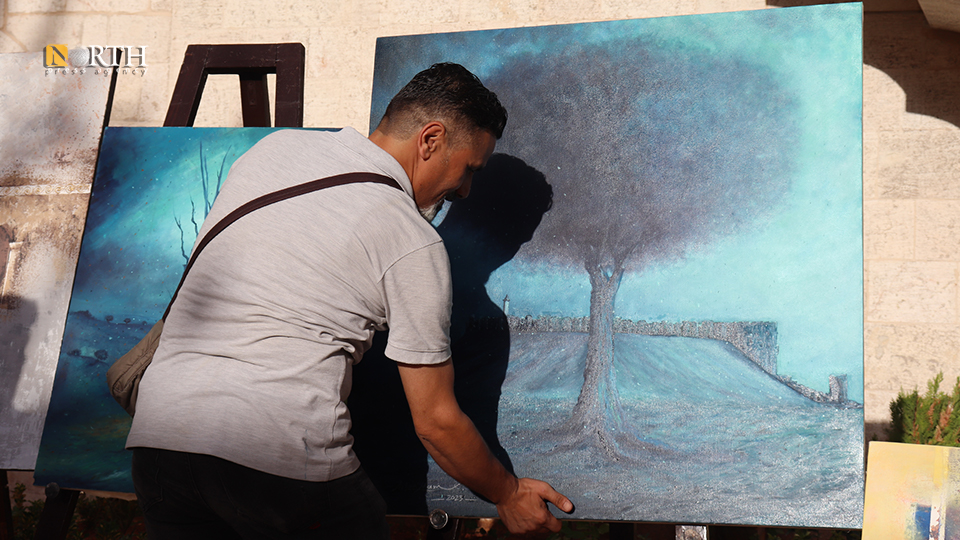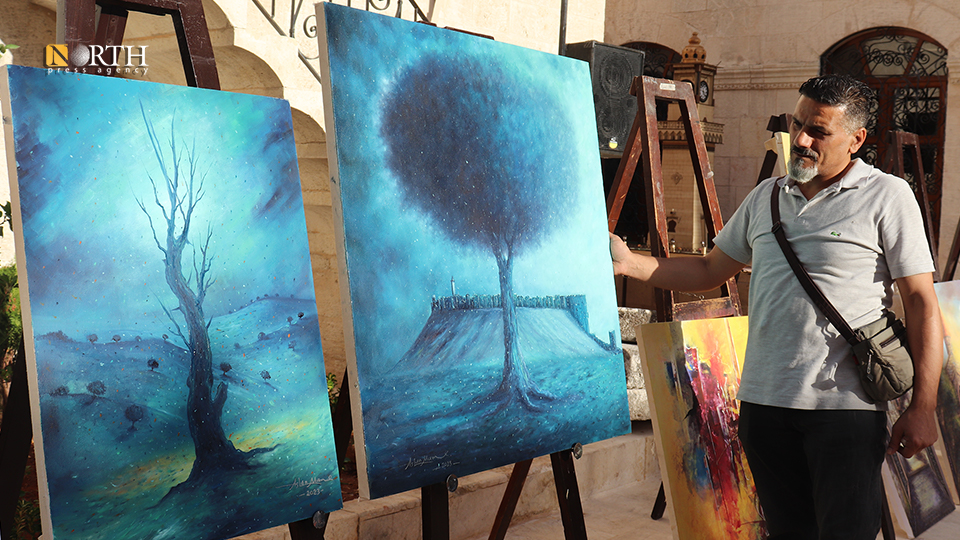Artist from Afrin depicts yearning for hometown in paintings
By Ardo Juweid
ALEPPO, Syria (North Press) – Aslan’s heart has never strayed far from his beloved city, Afrin, even though he now resides at a distance. This profound connection is beautifully captured in his paintings, which express his yearning and deep affection for his hometown.
Aslan Ma’mou is a painter who currently resides in Aleppo where he was born and studied, but he originally hails from the countryside of Afrin, in northern Aleppo.
As part of an art event in the city of Aleppo, artists from Aleppo and the countryside of Afrin showcased their artworks embodying various ideas. Eighteen visual artists participated in the event, with some of the them displaying artworks of olive trees, a symbol of Afrin.
In Mar. 2018, Turkish forces and their affiliated opposition factions of the Syrian National Army (SNA) occupied the city of Afrin and its surrounding areas following a military operation dubbed ‘Olive Branch’. The operation resulted in the displacement of 300,000 of the region’s original inhabitants who, just like Ma’mou, still long for their hometown.
On Sep. 24, an art event was held in the city of Aleppo, northern Syria, under the title ‘Art as a vent to overcome pain.’ It featured the participation of 18 painters.

Ma’mou told North Press, “These artworks manifest the unity between Aleppo’s heritage and the beauty of Afrin’s olive trees,” which was represented in one of the artist’s paintings.
Ma’mou participated with two artworks, one of which merged the heritage of Aleppo Citadel with an olive tree symbolizing the nature of Afrin.
In a bid to illustrate the impact of security chaos in Afrin under the SNA rule upon the locals, the artist embodied the endangered olive trees, depicting their plight through art.
SNA factions continue to cut off olive trees in Afrin. Since the beginning of 2023, they have chopped off 10,059 trees, with the aim of selling them, create a space to establish military bases, among other things.
Ma’mou said that the painting stands out from the rest with its branches symbolizing the history of the land and its enduring existence.
He said, “Afrin’s nature has been present on my canvases since my childhood. It continues to accompany me to this day and will accompany me in future works.”
The artist’s second painting depicts Afrin after the occupation, a period marked by the loss of numerous trees and the displacement of its native inhabitants. It portrays a landscape of barren plains and hills, stripped of life, where olive branches stand bare and leafless.
Ma’mou said, “No one can detach humans from mother nature.”
Various artworks
The exhibition showcased diverse artworks, as the artists used various techniques in color composition and capturing Aleppo’s heritage.
Ma’mou believes that participating in such events is essential for every artist, as it provides an opportunity for each artist to share different perspectives.
Ma’mou’s perspective is deeply rooted in his experience of living between rural areas and the city. The nature of Afrin, with its sprawling plains and majestic hills, has left an indelible visual imprint on him. Inspired by this, he made a decision to blend the elements of Afrin nature and Aleppo heritage in his work.
Challenges
The artists conveyed a resolute message through this exhibition, illuminating the significance of safeguarding cultural heritage and preserving endangered art.
Ma’mou further elaborated that “art holds a significance here in shaping a different vision of reality and highlighting the challenges faced by communities affected by conflicts.”
Ma’mou shed light on the challenges encountered by artists amid the dire circumstances prevailing in the country, primarily due to the deteriorating economic situation.
Despite his aspirations to hold five exhibitions he has prepared for, the current economic conditions and the exorbitant costs associated with organizing such events prevent him from realizing this heartfelt desire.
“These challenges have a widespread impact on all sectors of society and extend beyond the boundaries of art and artists. However, artists possess a unique character that sets them apart, particularly those who have experienced displacement from their land, homes, and their modest studios, finding themselves distanced from nature and their once permanent place,” he says.
He regarded exhibitions as a vital outlet for artists to express their ideas, break free from isolation, engage with society, and enhance the artistic landscape.

